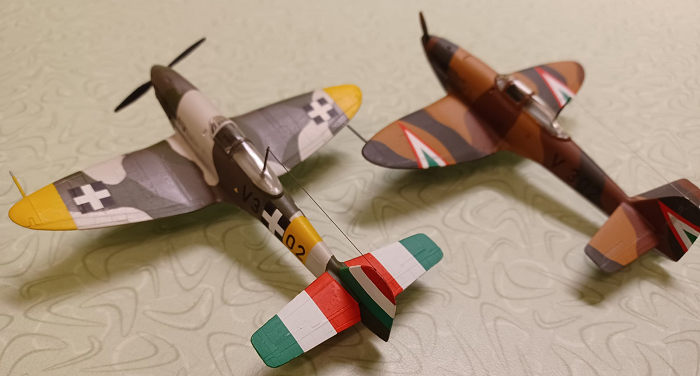
Heller 1/72 He-112B
| KIT #: | 80240 |
| PRICE: | $5-20.00 'used' |
| DECALS: | Two options |
| REVIEWER: | Christopher Campbell |
| NOTES: |

| HISTORY |
Ah, the Heinkel He.112; the elegant also ran to the more well-known Messerschmitt Bf.109. With just over one hundred being produced over four years, including prototypes, it somehow managed to serve in five countries in limited numbers. It has been grossly overshadowed by the much more numerous and extensively developed Messerschmitt, yet this who flew this graceful fighter seemed quite fond of it.
It has its origins in the same 1934 specification issued by the Luftwaffe for a new, single engine monoplane fighter (technically a “courier plane,” to subvert the interwar prohibition of fighters of the Versailles Treaty.) that would give the world the infamous Messerschmitt Bf.109. Arado also submitted Ar.80, a somewhat dated design with an open cockpit design with fixed, spatted landing gear an open cockpit. Focke-Wulf submitted a rather odd design, the Fw.159, which did have a retractable undercarriage (Though by all accounts an inordinately complicated retractable undercarriage.) It was, however, an already antiquated looking parasol monoplane and almost laughably fragile in appearance, giving it a somewhat more dated look than the Arado Ar.68 biplanes already in service.
Even with its fixed landing gear, the Arado entry managed to look more modern, and certainly more rugged. (I noticed that the monoplane fighter of the unnamed “enemy” seen in the apocalyptic 1936 H.G. Wells film “Things to Come” is quite evocative of this aircraft. Coincidence?) Still, neither of these stood a chance against the very modern designs from Heinkel and Messerschmitt.
The Heinkel showed definite promise and was the initial front runner with its wide-track, retractable landing gear and very efficient elliptical wing that was scaled down from their successful He.70 Blitz airliner/fast mailplane/recon bomber. (This wing influenced the design Spitfire quite notably as well.) At this point, it was still an open cockpit design,fitted with a simple windscreen. This would change in later prototypes and production aircraft, though.
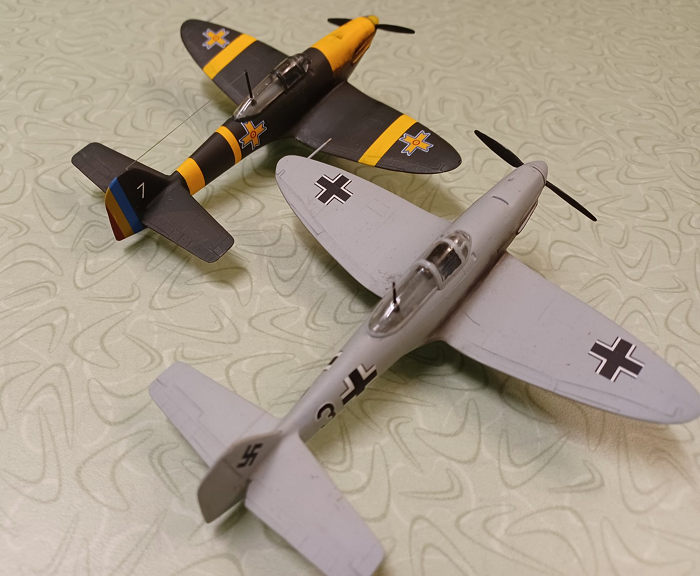 Both
fighter designs were initially fitted with Rolls-Royce Kestrel engines, the
Junkers Jumo inverted V-12 not yet available when testing began. Both were
experimentally fitted with several 7.9mm machine gun configurations in tests.
However, while 20mm canon would later begin to be fitted to the Messerschmitt
when the “E” model or Emil arrived, the He.112 began being fitted with them in
wings starting with the third prototype.
Both
fighter designs were initially fitted with Rolls-Royce Kestrel engines, the
Junkers Jumo inverted V-12 not yet available when testing began. Both were
experimentally fitted with several 7.9mm machine gun configurations in tests.
However, while 20mm canon would later begin to be fitted to the Messerschmitt
when the “E” model or Emil arrived, the He.112 began being fitted with them in
wings starting with the third prototype.
There were some most interesting variations tried throughout the prototype process. In 1937, one was even lent to Wernher von Braun’s rocket team at Peenemunde where it would be fitted with two different types of rocket motors in the tail over a series of tests to explore the potential of rocket propulsion. These proved largely successful despite some minor incidents. However, before being loaned as a test article, this aircraft had also been proposed for development as a carrier fighter, a role that would ultimately go to the Bf.109T. Though due to the aircraft carrier Graf Zeppelin never being completed, it was a role in which neither would ultimately serve.
The Heinkel was clearly an aircraft with some potential and could out turn the Messerschmitt, though the latter began to outperform it overall it once fitted with the Junkers engine. Even when fitted with the same Jumo 210D, the He.112 could not reach the same top speed as its angular competitor, nor climb or dive as quickly. A spin test resulted in the loss of a prototype in a crash, while the 109 came through with flying colors. While the Daimler-Benz DB 600 engine fitted in lieu of the Jumo of final prototypes improved horsepower to nearly 1,000 through a variable pitch-three blade propeller, fully enclosed cockpit with excellent visibility all around, and reduced turtledeck, it was too little and too late.
The die was cast and Messerschmitt Bf.109 would go on to become the frontline, workhorse fighter of the Luftwaffe through the end of World War II. With the contract let to the competitor, in most cases, that would be the end of the losing aircraft, with a handful of prototypes likely broken up for scrap and its being relegated to “also ran” status in history. Such would not exactly be the case with the He.112.
Ernest Heinkel would not be so easily deterred. His rivalry with Willy Messerschmitt as a designer was quite well known, and this snubbing by the RLM doubtless served to pour aviation gasoline on that flame. Recognizing the potential of the design, export markets for the fighter were sought. The V-9 prototype for what would become the ultimate version, the He.112B-1, was put on tour throughout Europe to entice potential customers in 1937. Aside from the three-blade propeller, which would revert to a variable pitch two blade unit for the production models, this was effectively the definitive form of the aircraft, with a fully enclosed sliding canopy, twin cowl mounted 7.9mm machine guns and twin wing mounted 20mm cannon.
In production it would be powered by the Junkers Jumo 210D producing 689 horsepower, the aircraft was now capable of just over 300 miles per hour. Its service ceiling was 26,000 feet, while its range was 680 miles. Despite the Bf.109 already entering service, the RLM continued to show some limited interest in the aircraft, ordering six more aircraft for evaluation, though nothing would ever come of it.
Austria, Finland, the Netherlands, and Yugoslavia all showed interest in the aircraft, though no sales were made. The first customer would actually be Japan, with the Japanese navy ordering two dozen with an option for four dozen more. Only twelve would actually be received, though. The remaining twelve being commandeered by the Luftwaffe as war tensions mounted over the Sudeten annexation.
Its service in Japanese hands would be short-lived, however. The liquid cooled engines required more maintenance than the air-cooled types that virtually all Japanese aircraft carried. Additionally, while it had been acquired as a fast climbing, land-based interceptor, Japanese Navy pilots disliked its handling when compared to their nimble Mitsubishi A5M’s. Such would not be the case with other customers, however.
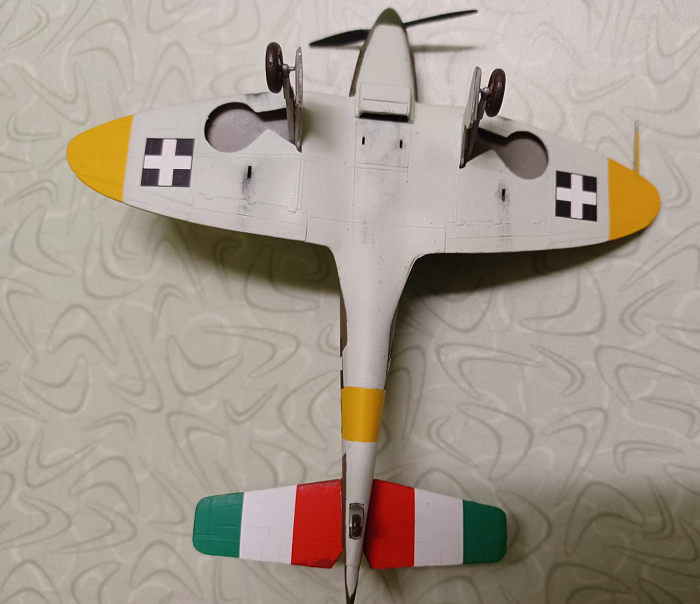 Even while still in evolving prototype, like the rival Messerschmitt, it would
see its first taste of combat with the Condor Legion in the war-torn skies of
Spain during the Spanish Civil War. This first example would be the V6 Cannon
Vogel Prototype featuring a single 20mm firing through the hub rather than dual
wing mounted cannon as in the production models. This also featured, as did the
early prototypes, and open cockpit and prominent dorsal spine.
Even while still in evolving prototype, like the rival Messerschmitt, it would
see its first taste of combat with the Condor Legion in the war-torn skies of
Spain during the Spanish Civil War. This first example would be the V6 Cannon
Vogel Prototype featuring a single 20mm firing through the hub rather than dual
wing mounted cannon as in the production models. This also featured, as did the
early prototypes, and open cockpit and prominent dorsal spine.
The aircraft was received enthusiastically, and its cannon proved capable at piercing light armored cars and even tanks then in service with Republican forces, making it possibly the first “tank buster” aircraft. It was used quite successfully in this role until a hard, forced landing due to an engine failure ended its service. Prototypes V8 and V9 would also serve with the Condor Legion before the close of hostilities, again mainly serving in the ground attack role.
While the 109 had generally outshone the He.112 in Spain, an order for more aircraft was forthcoming with a total of nineteen seeing service there. These would go on to serve in the post-Civil War Nationalist Air Force until 1944, including serving in Spanish Morocco where one is known to have tangled with a P-38 that strayed into Spanish airspace during Operation Torch, damaging the American fighter.
Hungary attempted to obtain as many of thirty-six aircraft, though in the end would only receive three. Initially, due to German neutrality the Hungarian-Romanian border dispute in the area of Transylvania, no aircraft were delivered. Then, Romania placed and order for aircraft that would be given priority supersede the Hungarian order production. Even attempts to obtain licenses and produce the aircraft indigenously would come to naught. In total, Hungary would receive a mere three airframes that would serve until sometime mid war when succeeded by aircraft such as the Bf.109G and Fw.190.
Romania would be the most numerous and final operator of the type. Thirty were received and used in combat from the first day of their entry to the War and scoring kills against a variety of Soviet aircraft, including both fighters and bombers. They also would comprise the first Romanian night fighter unit.
Despite their enthusiasm for the aircraft, the handful that they operated suffered from wartime attrition, general wear and tear, and often a lack of spare parts. Those that remained would be removed from front line service in late 1944, though would continue to serve in some capacity after Romania had extricated themselves from the Axis and joined the allies against the Nazis.
By April of 1946, only a single aircraft remained, though its fate was sealed. War-weary and barely what could be called serviceable, it was slated for the scrapyard. It never made it there. Developing engine trouble en route, it was landed at an auxiliary airfield and left where it sat.
The exact date that it was broken up is unknown. What is known is that none of these graceful machines survive today. That is rather a pity as one in the pale grey and striking red/yellow/blue Romanian insignia would look lovely sitting in a museum today.
While sometimes considered the progenitor Heinkel He.100, it was so principally only in chronological age and name. This latter aircraft differed quite significantly from 112 and shared very few, if any common components or design elements.
Thus, ended the somewhat abortive saga of Heinkel He.112. I have sometimes analogized it as the German Brewster Buffalo. There are some similarities to this aircraft its story and historical perception. In some respects, it was the “Buffalo” to the 109’s “Wildcat.”
It was a slightly, though only slightly, dated design from the onset. Initially favored by the RLM, the Bf.109 soon became the preferred aircraft. Like the Buffalo, some of the construction techniques, particularly of the wings, did not well lend themselves to the sort of mass production that would ultimately be required by the Luftwaffe. Additionally, discussing, comparing, and contrasting it with the 109 can be almost as polarizing as discussing the Buffalo. It has its true devotees as well as those who viewed it as always having been relict and devoid of redeeming qualities, save as a stop gap effort.
One thing can almost universally be agreed upon, however. From what accounts survive, all who flew the aircraft seem to have looked upon it fondly, finding it to have been a fine handling machine with few vices. At least for that and its overall clean aesthetic, it should be remembered.
| THE KIT |
Released by Heller in 1979, this was the first injection molded kit of the Heinkel He.112. The only previous offering had been a Rareplanes vacuform kit from 1971 (my first vacuform kit, actually, though given my level of experience at the time, the less said about that the better (I was only ten or eleven when I attempted it)). Molded in grey plastic, it is typical of Heller kits of this era. It is decently molded, flash free, though with very little in the way of cockpit of wheel well detail.
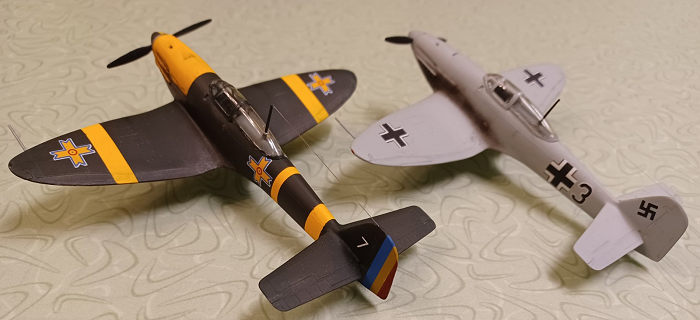 The only optional parts for the kit are the cowl panels, featuring the B-0 type
with the single, shrouded exhaust pipe on either side or the B-1 type with six
exhaust stubs per side, reminiscent of the 109. Decals provided are for German
and Romanian aircraft. However, this was subsequently released by Encore in 1993
and also included decals for Spanish aircraft. It has been in production more or
less constantly somewhere since its introduction. However, while I sometimes
find these kits going for $5 or so on vendor tables, at other times, it seems
one cannot find them for less than twenty dollars, something of a spread for a
basic 1/72 kit on the second hand market.
The only optional parts for the kit are the cowl panels, featuring the B-0 type
with the single, shrouded exhaust pipe on either side or the B-1 type with six
exhaust stubs per side, reminiscent of the 109. Decals provided are for German
and Romanian aircraft. However, this was subsequently released by Encore in 1993
and also included decals for Spanish aircraft. It has been in production more or
less constantly somewhere since its introduction. However, while I sometimes
find these kits going for $5 or so on vendor tables, at other times, it seems
one cannot find them for less than twenty dollars, something of a spread for a
basic 1/72 kit on the second hand market.
Newer kits have been released since. There was a VeeDay offering and more recently some fairly well-done, quality resins from Ludemann-Modellbau and Denko representing the various prototypes as well as recent kits from RS models representing several versions as well as some of the prototypes.
The He.112 has also been kitted in 1/48 by Classic Airframes in 1997. Rest Models produced and excellent resin of the V-6 cannon armed prototype in 1/48 in 2006 (This is essentially my holy grail of 1/48 kits, as I was unaware of it at the time, so missed purchasing it. I have only seen one built up, beautifully, I might add. However, I have never found one for sale or even seen the kit in the box.) {check the archives. Ed} Just recently LF Models has released new mold 1/48 He.112’s in both “production” versions. I plan to acquire at least one of these and see what it is like. I suspect that it will be an improvement over the earlier kit from Classic Airframes. No kit has ever been released in 1/32 to my knowledge, though I would love to see one, and build it, of course.
| CONSTRUCTION |
I built these four kits as a two dual builds, much in the manner of an assembly line. I knew in advance that I wanted to build the Hungarian machines and one Romanian, though I was undecided on fourth aircraft at first. I started out with the cockpit, what there is of it. It is rudimentary and typical of many kits of this period, consisting mainly of some rather barren cockpit sidewalls, a basic seat and floor, control stick (which features the correct and very Spitfire-esque oval grip handle) and instrument panel. Since construction was virtually identical for all four models, most details chronicled here will apply thusly.
Everything other than the instrument panel was painted in Model Master RLM 02 Grey. The panel was painted Testors Flat Black while the grip for the control stick was painted in Testors Rubber. Light dry brushing with Testors Aluminum was used to enhance some of the minimal detail. However, with the canopy molded in the closed position, very little will be visible.
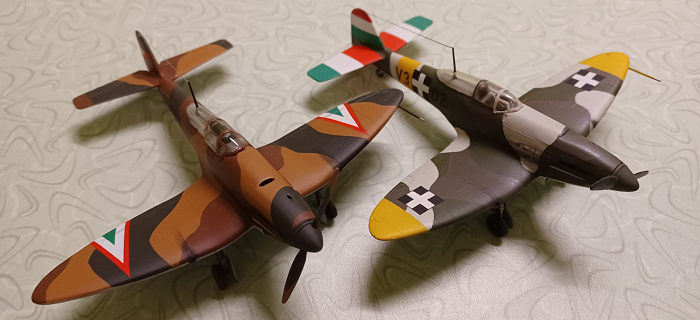 These parts were glued in place with some CA glue along with the radiator. Then
the fuselage halves were joined together using the same. The fit is usually
rather good on these, with only a minimum of cleanup and possibly very minor
filling CA glue and very little sanding required.
These parts were glued in place with some CA glue along with the radiator. Then
the fuselage halves were joined together using the same. The fit is usually
rather good on these, with only a minimum of cleanup and possibly very minor
filling CA glue and very little sanding required.
The wings fit well also. However, there is a problem here. As noted in editor Scott Van Aken’s review of his beautifully done Romanian He.112B, the landing gear bays are not enclosed, and just as he noted, you can see right in the cannon port on the wing and out of the wheel well.
I decided to address this cannon issue. I did so by cutting a piece of thin brass tubing and gluing it in place to represent the cannon. I did this one three out of the four and only omitted it from the last one because I did not have enough on hand for the last one.
In the case of these, I had simply sprayed the wing interiors with the same RLM O2 Grey before gluing them together. Two of these were glue together with CA glue and two using Plastruct liquid cement. I would say that the bond was about the same in both builds, with, again, very minimal sanding required.
One can install the cowl panels for the model selected before joining the fuselage and the wings. However, if any sanding is required due to not getting a clean join, detail from the cowl may accidentally removed when doing so. There may be some minor sanding needed around the cowl panels, though mine all fit very cleanly with only a light touch needed to smooth things out.
These can be attached at any point during the assembly. I chose to attach mine at this point because all of these were B-1 variants featuring the multiple exhaust ejectors. I was concerned that I might eliminate some of the detail on them when sanding the wing joint if needed, so this was why I chose to put them on last.
Lastly, the horizontal tail planes present no problems in my experience, generally easy to glue in place with a clean join and minimal, if any cleanup needed. With this step completed, it is ready to paint.
| COLORS & MARKINGS |
Painting began with spraying the wheel wells and interior gear doors in Model Master RLM 02 Grey. The former was then stuffed with damp paper towels and the real painting began. First to be addressed were the yellow I.D. bands on the Romanian and one of the Hungarian aircraft. This along with the spinner were sprayed in Testors Flat Yellow and masked off when dry. The spinner has a panel of approximately one quarter painted in the upper surface color. The spinner was masked accordingly (A little tricky with so diminutive a part). The Testors Yellow was a little too intense for my to my eyes and it was toned down with a splash Flat White when the I.D. markings were painted on the Hungarian aircraft.
The simplest of them would be the German aircraft. This would be overall grey, modeled as Heinkel aircraft factory plant defense aircraft seen on the back of the Squadron Signal He.112 In Action book. This was painted in Tamiya XF-16 Flat Sky Grey, along with the spinner and the gear covers and set aside to try. Done; one down.
The ventral surface of one of what would be one of the Hungarian aircraft was also sprayed in the same color. The other was sprayed in Testors Model Master Duck Egg. Lastly, the Romanain aircraft was given a underside coat of Tamiya XF-23 Flat Light Blue.
Both Hungarian aircraft would wear three tone camo schemes, so these would require somewhat more complicated masking than the others. Additionally, two of the three colors on the aircraft with the earlier type triangular wedge insignia did not exactly correspond, in my opinion to anything that I had on hand in my rather extensive paint collection. Still, that was nothing particularly new, nor significantly a challenge.
The single common color to both aircraft was RLM Dunkel Grun. In this case, the color used was Tamiya XF-26 Dark Green. After masking off the underside with Tamiya tape, the upper surface of both models was sprayed, then set aside to dry. While this was drying, the underside of the Romanian bird was masked off and its upper surfaces and that wedge on the propeller were all sprayed in in Tamiya XF-27 Black Green.
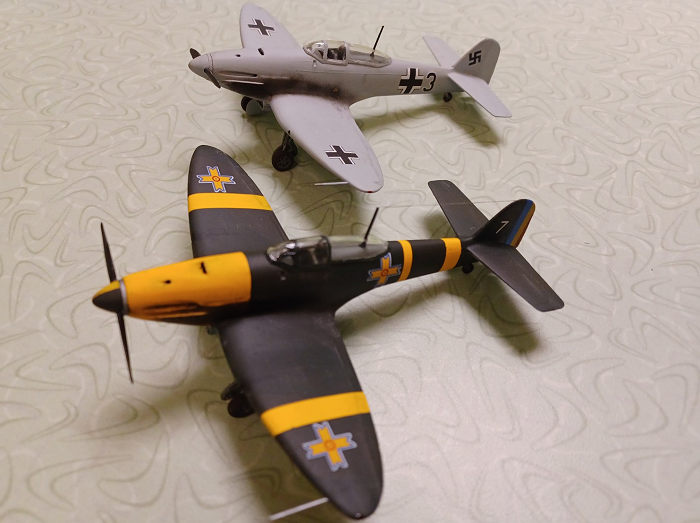 As paint was drying, I first addressed the remaining colors of the earlier
Hungarian paint scheme. The colors on the Aeromaster Heinkel He.112 decal sheet
#72-135 was the source for the decals for both Hungarian planes. It had color
callouts for these, though I did not have the color in question or did not like
the shade or tonal quality of the paint recommend. I decided to mix my own from
Tamiya paint.
As paint was drying, I first addressed the remaining colors of the earlier
Hungarian paint scheme. The colors on the Aeromaster Heinkel He.112 decal sheet
#72-135 was the source for the decals for both Hungarian planes. It had color
callouts for these, though I did not have the color in question or did not like
the shade or tonal quality of the paint recommend. I decided to mix my own from
Tamiya paint.
For the yellowish tan, Tamiya XF-60, Flat Dark Yellow was used as starting point and then tweaked with various Tamiya paints until I was satisfied with the shade. I have since dubbed this as “Hungarian Ochre.” The red-brown was created much in the same way, using Tamiya XF-64 as a starting point and adding a few splashes ofXF-9 Hull Red and XF-68 Nato Brown until I was again satisfied.
The appropriate areas were masked off and the red-brown was applied first, followed by another masking application of the ochre to the appropriate areas. Also, the propeller was painted time for this aircraft as well, as it was not the usual flat black as the other three has already been painted. Instruction on the decal sheet indicated that this aircraft was one of the rare ones with a camouflaged propeller, being dark green, with ochre applied in pattern over more or less the outer third of each blade. It would be, to say the least, unusual looking.
With this done, I turned my attention to the final aircraft, the wartime Hungarian aircraft. The green was now masked off appropriately for the patter and Model Master Dunkelbraun RLM 61. Once this had dried, it was again masked and final color. Model Master Lichtgrau RLM 63 was applied.
The masking was removed from all of the models and any needed touch ups were applied. Was very pleased to find that only a minimum of touchups were needed on any of them. The exhaust stubbs were painted in Testors Rust and accented by dry brushing with Model Master Dark Anodonic Grey. The landing gear were also painted in the Model Master color at this time. The tires were painted in Testors Rubber, with hubs Dark Anodonic Grey and the brake drums in Testors Rust, again dry brushed and accented in the same way as the exhaust. The radiators were painted with Model Master Burnt Iron and accented by dry-brushing with Andodonic Grey.
The landing gear assemblies represented no problems. They are very simple and fit together quiet simply. Once glued in place, the landing gear covers were now attached as well. Now it was time decal them.
All four aircraft were given a coat of Model Master spray clear gloss. When this had dried, decals from the aforementioned Aeromaster decal sheet with the exception of the Romanian aircraft for which I gleaned the kit decals and from several remnant sheets in my decal stash. In all cases, decals went on quite well and settled down nicely with a small amount of Solvaset.
The decal problem worth noting is that the tricolor decals for the horizontal stabilizers of the wartime Hungarian aircraft were what I would call a 90%+ fit, but not perfect. A small amount of touchup paint was required, mainly on the leading and trailing edges of the wings. Once all were thoroughly dry all of the models were sprayed in Modell Master Dullcoat.
| FINAL CONSTRUCTION |
There was now little left to do to finish these kits out. Some general weathering was applied with an oil wash to all. The gun blast and exhaust staining was done by dry brushing Tamiya Flat Balck and/or Tamiya smoke. The exhaust staining was made particularly heavy on the grey Heinkel plant defense aircraft in keeping with the illustration on the back cover of the Squadron In Action Series book.
The radio masts were installed along with the pitots and propellers and spinners. They were then given another light coat of Dullcoat and attention was turned to the canopies.
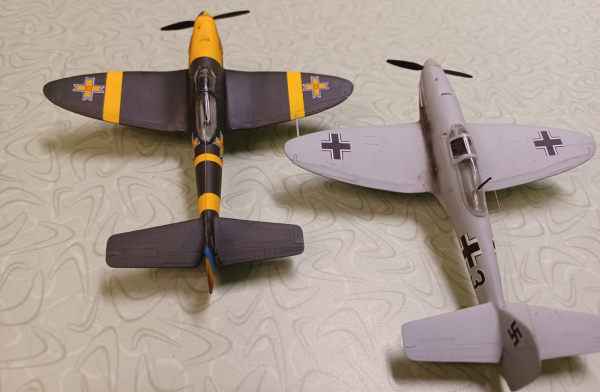 These are more or less the correct shape, though are thickly molded. I have
found that it is worthwhile to enlarge the hole for the radio mast to pass
through ever so slightly. I found this out the hard way when I built my first
one when I was college and broke the mast trying to attach the canopy.
These are more or less the correct shape, though are thickly molded. I have
found that it is worthwhile to enlarge the hole for the radio mast to pass
through ever so slightly. I found this out the hard way when I built my first
one when I was college and broke the mast trying to attach the canopy.
Of note, while the framing on either side of the sliding section is well enough represented in this scale, the right angle section on either side of the forward windscreen clearly seen in photographs is not even suggested as a molded line on any example of this kit that I have seen. So, be prepared with a fine brush and steady hand to add this.
A dunking in Future will help to clear up some of the problems with its thickness, enhancing its transparency. Unfortunately, if you wish to pose it open, a vacuform replacement will be needed, as it is to thick to be cut and repositioned.
Once painted, these were attached with my now favorite glue for clear parts, G-S Hypo Watch Crystal Cement. Simple aerials were rigged with thin E-Z line and my little Heinkel assembly line was finished with its run. I now had four Heinkel He.112B-1’s for my collection, all nice representations of the final “production” version of this fighter troubled not so much by design deficiencies as by possibly being the right aircraft at the wrong moment.
| CONCLUSIONS |
The Heller Heinkel He.112 kit is simple and easy to assemble, presenting very few problems. There are newer kits in 1/72 which are known to be more detailed, though this may not translate to the same ease of assembly. As a modeler, you will have to choose which path you take if choosing to model this elegant little aircraft.
I would say that I only spent around 9-10 hours at most on all four aircraft combined. That translates to rather rewarding results for minimal time invested. Easy builds like that also make for a nice break from either overly complex or ill-fitting models. I recommend the Heller He.112 to any modeler who wants a decent representation of this unique aircraft at a reasonable price (Though as noted previously that tends to vary a bit). It would also be good for a junior modeler wishing to try their hand at 1/72, as there is little about it that can be called troublesome or difficult.
| REFERENCES |
Warplanes of the Third Reich, by William Green, Galahad Books, 1990
Warplanes of the Luftwaffe, Editor David Donald, Aerospace Publishing, 1994
Hitler’s Luftwaffe, by Tony Wood & Bill Gunston, Salamander Books, 1977
Heinkel He.112 in action, Aircraft # 159, by Denes Bernad, Squadron Signal Publications 1996
https://en.wikipedia.org/wiki/Heinkel_He_112
17 April 2023
Copyright ModelingMadness.com. All rights reserved. No reproduction in part or in whole without express permission from the editor.
If you would like your product reviewed fairly and fairly quickly, please contact the editor or see other details in the Note to Contributors.